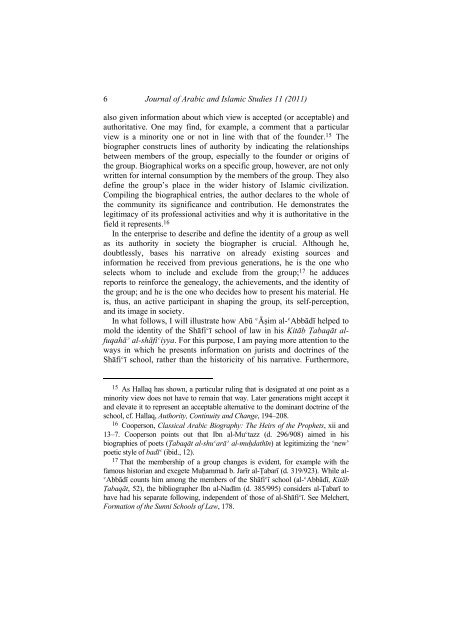JOURNAL OF ARABIC AND ISLAMIC STUDIES
JOURNAL OF ARABIC AND ISLAMIC STUDIES
JOURNAL OF ARABIC AND ISLAMIC STUDIES
You also want an ePaper? Increase the reach of your titles
YUMPU automatically turns print PDFs into web optimized ePapers that Google loves.
6<br />
Journal of Arabic and Islamic Studies 11 (2011)<br />
also given information about which view is accepted (or acceptable) and<br />
authoritative. One may find, for example, a comment that a particular<br />
view is a minority one or not in line with that of the founder. 15 The<br />
biographer constructs lines of authority by indicating the relationships<br />
between members of the group, especially to the founder or origins of<br />
the group. Biographical works on a specific group, however, are not only<br />
written for internal consumption by the members of the group. They also<br />
define the group’s place in the wider history of Islamic civilization.<br />
Compiling the biographical entries, the author declares to the whole of<br />
the community its significance and contribution. He demonstrates the<br />
legitimacy of its professional activities and why it is authoritative in the<br />
field it represents. 16<br />
In the enterprise to describe and define the identity of a group as well<br />
as its authority in society the biographer is crucial. Although he,<br />
doubtlessly, bases his narrative on already existing sources and<br />
information he received from previous generations, he is the one who<br />
selects whom to include and exclude from the group; 17 he adduces<br />
reports to reinforce the genealogy, the achievements, and the identity of<br />
the group; and he is the one who decides how to present his material. He<br />
is, thus, an active participant in shaping the group, its self-perception,<br />
and its image in society.<br />
In what follows, I will illustrate how Abū ʿĀṣim al-ʿAbbādī helped to<br />
mold the identity of the Shāfiʿī school of law in his Kitāb Ṭabaqāt alfuqahāʾ<br />
al-shāfiʿiyya. For this purpose, I am paying more attention to the<br />
ways in which he presents information on jurists and doctrines of the<br />
Shāfiʿī school, rather than the historicity of his narrative. Furthermore,<br />
15 As Hallaq has shown, a particular ruling that is designated at one point as a<br />
minority view does not have to remain that way. Later generations might accept it<br />
and elevate it to represent an acceptable alternative to the dominant doctrine of the<br />
school, cf. Hallaq, Authority, Continuity and Change, 194–208.<br />
16 Cooperson, Classical Arabic Biography: The Heirs of the Prophets, xii and<br />
13–7. Cooperson points out that Ibn al-Muʿtazz (d. 296/908) aimed in his<br />
biographies of poets (Ṭabaqāt al-shuʿarāʾ al-muḥdathīn) at legitimizing the ‘new’<br />
poetic style of badīʿ (ibid., 12).<br />
17 That the membership of a group changes is evident, for example with the<br />
famous historian and exegete Muḥammad b. Jarīr al-Ṭabarī (d. 319/923). While al-<br />
ʿAbbādī counts him among the members of the Shāfiʿī school (al-ʿAbbādī, Kitāb<br />
Ṭabaqāt, 52), the bibliographer Ibn al-Nadīm (d. 385/995) considers al-Ṭabarī to<br />
have had his separate following, independent of those of al-Shāfiʿī. See Melchert,<br />
Formation of the Sunni Schools of Law, 178.

















